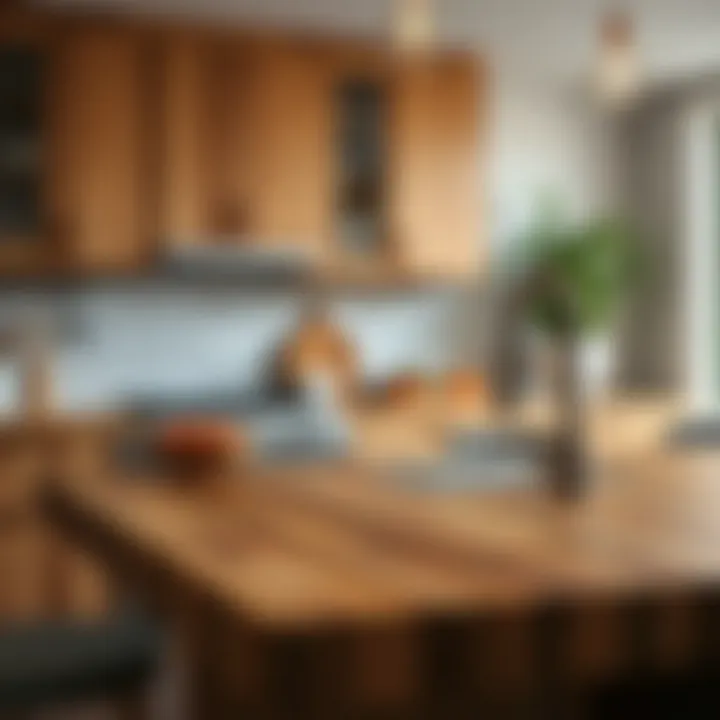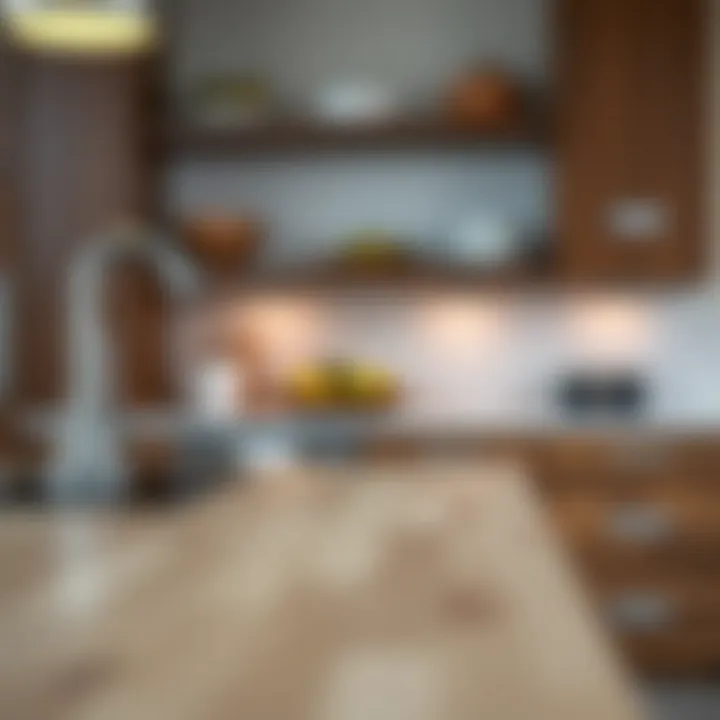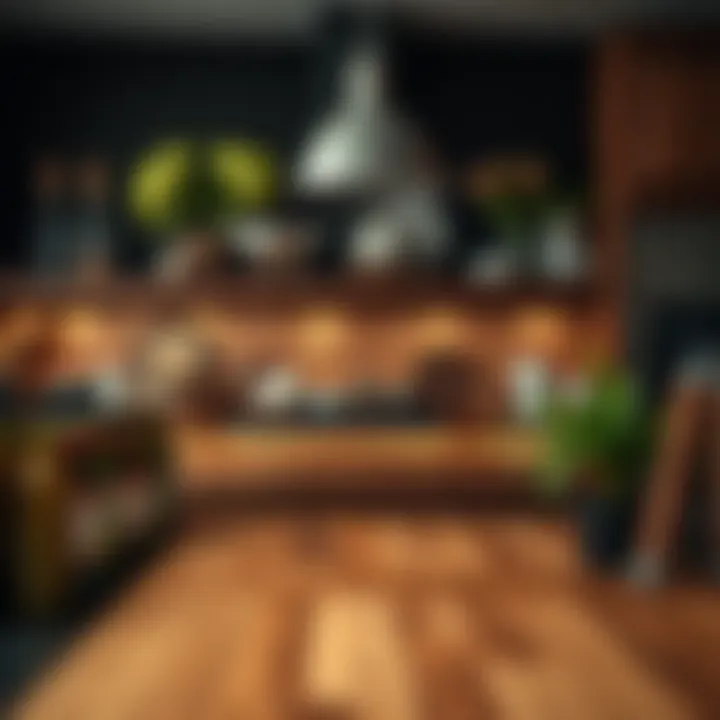Exploring Finishes for Butcher Block Countertops


Intro
Butcher block countertops stand as a versatile choice for any kitchen, blending functionality with a rustic charm. Their ability to withstand wear and tear, along with their aesthetic appeal, makes them a popular option among homeowners and designers. Yet, what truly sets these surfaces apart is the finish that encompasses them. The right finish not only protects the wood from damage but also influences the overall look and feel of the kitchen environment. By diving into various finishes available — from natural oils to synthetic coatings — this article aims to illuminate the nuances involved in selecting the perfect finish for your butcher block countertops.
Furniture Styles and Trends
Exploring Popular Furniture Styles
The kitchen is the heart of the home, and the choice of countertops can significantly reflect and enhance the furniture style prevalent in that space. Butcher block countertops often find themselves at home in several popular furniture styles.
- Farmhouse Style: Often characterized by a simple aesthetic and rustic elements, butcher block enhances the cozy vibe, complementing shaker cabinets and vintage fixtures.
- Modern Minimalist: A stark contrast to farmhouse, here the emphasis is on clean lines and simplicity. Butcher block can add warmth to a cool-toned modern design, especially with a natural oil finish.
- Industrial Chic: This style marries practical materials with a raw aesthetic. Butcher block, paired with exposed metal shelves and concrete accents, can create a balanced, inviting space.
Understanding Current Design Trends
Current trends in kitchen design continue to favor materials that are both practical and visually engaging.
- Sustainable Choices: There’s a growing inclination toward sustainably sourced wood for butcher blocks. This not only aligns with eco-conscious consumerism but also supports local artisans.
- Multi-functional Spaces: The rise of open-plan living calls for countertops that serve multiple roles, be it meal prep, casual dining, or even a workspace. This versatility often nudges homeowners towards finishes that are durable and easy to maintain.
- Textured Finishes: More designers are experimenting with textured finishes, redefining traditional smooth surfaces. A well-sanded butcher block can bring an organic feel to contemporary designs, marrying user experience with raw beauty.
Practical Tips for Countertop Selection
Factors to Consider When Choosing a Finish
Choosing a finish isn’t merely about aesthetics. There are several practical elements to ponder:
- Durability: How well can the finish endure scratches, heat, and moisture?
- Maintenance: Some finishes require regular reapplication, while others may need little attention.
- Food Safety: Especially vital for kitchen surfaces, ensuring the finish is food-safe can preserve both health and taste.
How to Measure and Optimize Space
Understanding your space is just as vital as finishing touches. Here are some guidelines:
- Measure Twice, Cut Once: Accurate measurements ensure countertops fit snugly, avoiding awkward gaps.
- Consider Workflow: Think about the kitchen work triangle (sink, stove, refrigerator) and place countertops where they’ll optimize flow.
- Visual Balance: Ensure your butcher block integrates well visually with existing cabinetry and appliances. A cohesive look will amplify the overall aesthetic of the kitchen.
An informed choice can elevate your butcher block from mere functionality to a striking centerpiece in your home.
The journey of selecting the right finish is a roadmap to a kitchen that is both a culinary haven and an aesthetically pleasing space.
Intro to Butcher Block Countertops
Butcher block countertops hold a special place in the hearts of many homeowners and kitchen designers. Their warm, natural wood appearance adds character to any kitchen, creating an inviting atmosphere for cooking and gathering. While aesthetics are an important consideration, the functionality and practicality of butcher block countertops are equally vital. The choice of finish can be a game-changer, affecting durability, maintenance requirements, and sometimes even food safety. In this article, we will explore the different finishes suitable for butcher block countertops, and shed light on their unique properties and applications.
History and Evolution
The history of butcher block countertops is rooted deeply in practicality. Traditionally, these surfaces were made from hardwoods like maple or oak, designed for butchers to prepare meat and other food items. Over the years, the evolution of butcher blocks has seen them transition from simply functional workspaces to refined kitchen elements that enhance aesthetics. While once relegated to professional kitchens, butcher blocks began appearing in home kitchens in the early 20th century. As home cooking gained popularity, so did these countertops.
Today, the butcher block's legacy lives on through various styles and finishes that cater to modern tastes. Homeowners now have the opportunity to select materials and finishes that not only complement their kitchen design but also withstand the test of time.
Popularity in Modern Kitchens
In recent years, butcher block countertops have seen a resurgence in popularity among homeowners and interior designers alike. This trend can be attributed to their multiple benefits:
- Versatility in Design: Butcher blocks can fit into various design styles, from rustic farmhouse to sleek contemporary kitchens. They serve as a captivating focal point or harmonize with other materials like stainless steel or tile.
- Eco-Friendly Appeal: With a growing focus on sustainability, many homeowners appreciate that hardwoods, when sourced responsibly, offer a greener alternative to certain synthetic materials. This environmental factor resonates well with those looking to create more eco-conscious homes.
- Functional Surfaces: Beyond their aesthetic charm, butcher blocks provide a tough, durable surface for food preparation. They withstand cuts and dings, making them a practical choice for home cooks.
Types of Butcher Block Materials
Selecting the right material for your butcher block countertop is more than just an aesthetic choice; it speaks volumes about durability, maintenance, and your overall kitchen experience. The materials used not only dictate how easy it will be to keep your countertops looking sharp, but they also play a crucial role in how they will hold up under the wears and tears of daily use.
In this section, we delve into two primary types of butcher block materials: hardwood options and bamboo alternatives. Each has its unique traits, merits, and potential drawbacks. The choice between these materials can influence not just the performance of your countertop but also its integration with your kitchen’s design and functionality.
Hardwood Options
Hardwood countertops stand out for their beauty and strength. They come from various trees, providing a rich palette of colors and grains. Wood types like maple, walnut, and cherry are particularly popular choices. These woods are dense and sturdy, making them resistant to nicks and scratches which is vital for a surface meant for chopping and prepping food.
One advantage of hardwood is its natural capacity to self-heal minor scratches over time. Using a planed surface enhances this self-repair quality, making it much less likely for small cuts to become permanent fixtures in your countertop.
However, maintaining hardwood requires some conscious effort. Regular oiling is necessary to keep the grain well-conditioned and prevent drying out or warping. Here are several benefits and considerations:
- Aesthetic Appeal: Each type of hardwood has distinctive colors and textures that can complement various kitchen styles.
- Customizability: Hardwoods can be easily sanded and refinished if they ever get worn out or damaged.
- Environmentally Friendly: If sourced from sustainable forests, hardwoods can be a more eco-friendly choice compared to synthetic materials.
- Initial Cost: They often come with a heftier price tag compared to other options, so consider your budget carefully.
Bamboo Alternatives
Bamboo is becoming increasingly popular as an alternative to traditional hardwoods. Recognized for its rapid growth and sustainability, bamboo countertops deliver a unique look, with a natural light hue and noticeable striations that can add texture to a kitchen. This material is technically a grass, not wood, yet it provides comparable hardness to many hardwoods, which is a plus for kitchen surfaces.


Advantages of bamboo include:
- Sustainability: Bamboo is renewable and grows much faster than trees, making it a more responsible choice for eco-conscious homeowners.
- Resilience: It is naturally moisture-resistant and less prone to warping than some hardwoods, a significant consideration in kitchens.
- Value: Generally, bamboo countertops are wise investments due to their affordability compared to some hardwoods.
Yet, there are drawbacks. Bamboo has specific care needs, as it is susceptible to scratches and dents in a way that some denser hardwoods are not. Also, applying finishes requires particular types of treatments to ensure their resilience over time.
In summary, whether leaning toward hardwoods or bamboo, the choice of material significantly impacts both the practical and aesthetic outcomes of your butcher block countertop. Understanding these elements lays a solid foundation for ensuring your countertops not only fit your kitchen's style but also endure the rigors of daily cooking.
Factors to Consider in Choosing a Finish
Selecting the right finish for your butcher block countertop is not just about aesthetics, it’s akin to finding the perfect pair of shoes – comfortable yet stylish. A finish impacts how the wood ages, its resistance to staining, and its overall life expectancy. Not to forget, the right choice can grant peace of mind in terms of food safety. Therefore, several factors come into play when deciding on a finish.
Durability and Wear Resistance
Durability is paramount. A butcher block countertop is a working surface where food is prepared, hence it faces constant wear and tear. We want a finish that can stand up to the rigors of daily use.
- Material Matters: Some finishes can withstand heavy use much better than others. For example, a polyurethane finish forms a barrier that resists scratches and stains, while an oil finish may require more frequent maintenance to replenish its protective qualities.
- Life Span: How long you expect your countertop to last should influence your decision. Synthetic finishes, while sometimes seen as less natural, often provide a longer-lasting protective layer. Conversely, natural finishes like mineral oil may need reapplication every few weeks, which can be an inconvenience for busy kitchens.
The finish can be seen as an armor for your countertop, shielding it from the daily spills and cuts that come with culinary adventures.
"The right finish is like a sturdy umbrella on a rainy day; it keeps your countertop safe from the storms of daily use."
Food Safety Standards
When it comes to food-related surfaces, safety is of utmost importance. Chemical leaching from certain finishes may pose health risks if not chosen carefully. Here are some key considerations:
- Non-Toxic Options: Several finishes are deemed food safe. For instance, mineral oil and beeswax are popular because they do not introduce harmful chemicals into the food. Selecting a finish that meets food safety standards ensures that your countertop remains a safe space for food prep.
- Regulatory Compliance: Apart from basic safety, looking into finishes that comply with either FDA or other relevant regulations can provide additional peace of mind. Knowing that the product you choose is backed by regulatory approvals can strengthen your trust in its safety.
- Absorption Rate: Some finishes can absorb contaminants if they aren't regularly maintained. Choose a finish known for its repellent qualities, ensuring that your butcher block remains a sanctuary for culinary creativity, not a breeding ground for bacteria.
In a nutshell, when you decide on a finish, remember you are not only ensuring the beauty of your countertop, but also the safety of what’s prepared on it.
Natural Finishes Overview
The beauty of butcher block countertops can truly shine through the right finish. Natural finishes are often a go-to choice for homeowners looking for sustainable and food-safe options. They contribute not just to the appearance but also to the longevity of the surface. When choosing a natural finish, it's important to think about elements like ease of application, regular maintenance, and food safety standards. These finishes often enhance the grain and color of the wood, giving it a warm and inviting look.
Natural finishes encourage a healthy kitchen environment by avoiding harsh chemicals. Moreover, they're generally easier to maintain compared to synthetic alternatives. However, one should bear in mind that, while attractive and environmentally friendly, they may require more frequent reapplication to keep the surface protected and looking good.
"A well-finished butcher block can transform your kitchen into a culinary haven while harmonizing with nature's aesthetics."
Mineral Oil Finish
Mineral oil is often seen as a staple in the world of butcher block finishes. This clear, colorless oil is derived from petroleum, and its significance lies in its ease of use and effectiveness in protecting the wood. When applied, mineral oil penetrates the wood fibers, providing moisture throughout the material and preventing them from drying out and cracking.
Here are some points to consider regarding mineral oil:
- Ease of application: Applying mineral oil doesn't require any special tools. Just a cloth or a sponge will do.
- Cost-effective: It’s budget-friendly compared to many synthetic options.
- Food safe: Since it's non-toxic, it’s a great choice for surfaces that will contact food.
However, it’s essential to note that mineral oil is not a one-and-done solution. Regular re-application is key to maintaining the finish and ensuring the wood remains hydrated. Typically, every few weeks for the first couple of months and then every month afterward depending on usage will keep the surface in good condition.
Beeswax Finish
Beeswax finish adds an extra layer of charm and protection to butcher block countertops. Naturally derived from the honeycomb of bees, this finish has been used for centuries. It offers a unique combination of aesthetics and durability. Most notably, it creates a lovely soft sheen and can be mixed with other oils, like mineral oil, to enhance its protective qualities.
Benefits of beeswax include:
- Natural and non-toxic: As a natural product, it ensures a safer kitchen environment and is safe for food contact.
- Hydrophobic properties: This finish helps repel water and stains, making it particularly advantageous in a busy kitchen.
- Aesthetic appeal: The subtle luster it provides enhances the visual warmth of wood.
On the flip side, beeswax needs care. It may need to be reapplied more frequently compared to synthetic finishes, especially in high-use areas. You can apply it simply by rubbing it in with a clean cloth, but it will generally benefit from a thorough buffing to achieve that shine.
As you evaluate your options, think not just in terms of finishes, but in creating a functional and elegant space that serves your culinary ambitions.
Synthetic Finishes Overview
When it comes to finishing butcher block countertops, synthetic options often come into play. These finishes are specifically designed for modern kitchens, offering a robustness and aesthetic appeal that appeals to many homeowners and interior designers alike. Unlike natural finishes, synthetic finishes can provide layers of protection that resist scratching, staining, and moisture absorption. This overview will touch on important aspects of synthetic finishes, including their features, advantages, and crucial considerations that come into play during selection.
Polyurethane Finish
Polyurethane is perhaps the most popular synthetic finish for butcher block countertops. It forms a tough, durable layer over the wood, acting like a shield against daily wear and tear. Homeowners often appreciate its water resistance, making it suitable for kitchen environments where spills are a common occurrence. Polyurethane finishes are available in both oil-based and water-based formulas, each with its distinct characteristics.
Benefits of Polyurethane Finish:
- Durability: A polyurethane finish can last for years, reducing the need for frequent reapplication.
- Easy Maintenance: Cleaning surfaces treated with polyurethane can be a breeze, often requiring just a damp cloth to wipe away messes.
- Variety: With options available in glossy to matte sheens, there’s a polyurethane finish to match any design preference.
However, it is essential to consider some potential drawbacks. Once cured, polyurethane can be difficult to reapply over old layers. Matching the sheen of previous applications can be tricky, leading to a mismatched appearance on your countertop. Moreover, the drying time can be longer compared to its natural counterparts, which might hold up a project longer than desired.


Epoxy Finish
Epoxy finishes offer a completely different approach to butcher block protection. Often used in industrial settings, epoxy is becoming popular among homeowners looking for an innovative finish. This two-part system combines resin and hardener, resulting in a waterproof, chemical-resistant surface. For those looking for an immaculate look, epoxy can provide a glass-like finish that is truly stunning.
Key Features of Epoxy Finish:
- Waterproof: Once cured, epoxy creates a barrier that stops water from penetrating, making it ideal for areas near sinks.
- Chemical Resistant: Should you spill acidic or harsh chemicals, epoxy’s non-porous surface helps protect the wood beneath.
- Aesthetics: The ability to add colors, glitter or even textures makes epoxy an attractive choice for customizing countertops.
While there are several advantages tied to epoxy, consider that it requires precise application. Getting the mixture wrong can lead to unsatisfactory results, so attention to detail is crucial. Additionally, once applied, epoxy can be tough to remove if you wish to switch to another finish.
Using synthetic finishes like polyurethane and epoxy not only enhances your butcher block's durability but also extends its overall lifespan, allowing it to retain its beauty for years to come.
In summary, synthetic finishes provide robust options for homeowners looking to protect and beautify their butcher block countertops. Whether you go for the durability of polyurethane or the dazzling aesthetics of epoxy, weigh the pros and cons carefully. A finish not only impacts how often you need to maintain your surfaces but also how well they perform under the various stresses of everyday kitchen life.
Application Techniques for Finishes
When it comes to butcher block countertops, how you apply the finish can make or break the long-term beauty and functionality of the wood. Finishing isn't just a cosmetic touch—it's a vital step in preserving the integrity of your countertops. A well-applied finish helps to protect against moisture, stains, and damage, ensuring that your investment lasts as long as possible. Moreover, proper application can enhance the aesthetics of the wood, making the grain pop and giving it a lustrous sheen that can elevate your kitchen's ambiance. Thus, understanding application techniques is crucial for both seasoned professionals and homeowners alike.
Prepping Your Butcher Block Surface
Preparing your butcher block surface is not merely a preliminary step; it's the foundation upon which the durability of your finish rests. It all starts with cleaning the surface thoroughly. Dust, grease, or old finishes can ruin the bond between the wood and the new finish, leading to peeling or chipping down the line.
- Start by Sanding: Use fine-grit sandpaper to sand down the surface. This helps to remove any previous finish while also creating a texture that enables the new finish to adhere better. Always sand in the direction of the wood grain to avoid scratches.
- Dust Removal: After sanding, take a clean cloth or a vacuum to remove all dust and debris. Even the smallest speck of dust can lead to an uneven finish.
- Cleaning Solution: Wipe down the surface with a biodegradable cleaner that’s safe for food surfaces. This eliminates grease and prepares the wood for application.
- Drying Time: Make sure to let the surface dry completely before proceeding to the next step; moisture can ruin the finish.
Taking your time during this prep phase will save you hassle later on, as improper preparation can lead to a myriad of issues down the line.
Steps for Proper Application
Once your butcher block surface is prepped, the next step is applying the finish. Here’s a simple, yet effective method to ensure a successful application:
- Choose the Right Tools: A high-quality brush or a lint-free cloth can make a significant difference. Brushes are often better for smooth finishes, while cloths can be ideal for oil-based products, allowing for a more even coat.
- Follow Product Instructions: Every finish has prescribed application instructions. Don't skip this part: differences in drying times, application techniques, and the number of coats can vary.
- Apply Thin Coats: It’s better to apply multiple thin coats rather than one thick layer. Thick layers can take excessively long to dry and could lead to bubbles or streaks.
- Mind the Drying Time: Allow each coat to dry as per manufacturer recommendations. Patience here pays off.
- Sand Between Coats: For oil-based finishes, lightly sand between applications. This helps to create a better bond between layers, ensuring a smooth, beautiful finish when everything is completed.
- Final Inspection: Once the final coat is applied and thoroughly dry, inspect the surface for imperfections. If necessary, perform touch-ups where you see fit.
Following these steps methodically can lead to a finish that not only looks excellent but also stands the test of time, maintaining the butcher block’s attractive appearance and functionality.
"The right application can enhance not only the strength but also the beauty of your butcher block countertops."
In the end, taking these steps helps to bolster the longevity of your counters and maintain their striking appearance."
For more tips on maintaining your surfaces, you can visit Fine Homebuilding or check discussions on unique finishes in forums like Reddit.
Keeping these application techniques in mind will surely contribute to a successful finishing job and a beautifully sustained butcher block in your kitchen.
Maintenance of Butcher Block Finishes
Maintaining butcher block finishes is not just a chore; it's an essential part of caring for your kitchen. This section covers the importance of ongoing maintenance of these counter surfaces, contributing not only to their longevity but also to their aesthetic appeal. A well-maintained butcher block can serve as a centerpiece in your kitchen, showcasing its natural beauty while ensuring it remains functional and safe for food preparation.
Regular Cleaning Practices
Regular cleaning is the foundation of maintaining your butcher block finishes. It's like keeping your car in shape; a little care goes a long way. You’ll want to wipe down your countertop after each use. A gentle soap and warm water solution can do wonders—just avoid soaking it. Over time, water can seep into the wood, leading to warping or bacteria growth.
Here are some simple steps to ensure your butcher block stays spick and span:
- Daily Wipe Down: After food preparation, use a soft cloth to remove crumbs and spills.
- Deep Clean Weekly: For a more thorough clean, use a mixture of vinegar and water. This not only sanitizes but also helps maintain the wood's natural patina.
- Avoid Harsh Chemicals: Some cleaning agents can damage the finish or leach into food. Stick to mild solutions.
"A well-cared-for butcher block is a work of art—make sure it shines as brightly as your culinary skills!"
In addition to regular cleaning, it is essential to pay attention to the use of cutting boards and utensils. Using plastic or bamboo boards on your butcher block can mitigate scratches and abrasion, which could wear away the finish over time.
Reapplication and Touch-ups
Even the best finishes require a little rejuvenation now and then. Reapplication of your chosen finish ensures that your countertop continues to offer protection against moisture and wear. Think of it like regularly changing the oil in your car—it's about being proactive rather than reactive.
- Frequency: Depending on your kitchen habits, reapplication every 3-6 months can keep your butcher block in tip-top shape.
- Process: Start by cleaning the surface thoroughly. Then, apply a thin coat of your chosen finish—be it mineral oil for a natural option or polyurethane for added durability. Always follow the manufacturer’s guidelines for application. For touch-ups, focus on areas that show wear more prominently, like around the sink or stove. Here, the finish may wear down quicker due to moisture and heat.
- Additional Tips: During application, a fine-grit sanding may help to prepare the surface. Always let the finish cure properly—patience here pays off in performance.
In summary, maintenance of butcher block finishes is crucial for ensuring these surfaces remain both beautiful and functional. Your regular cleaning and timely reapplication can transform a simple countertop into a stunning feature of your kitchen.
Comparative Analysis of Finishes
In the realm of butcher block countertops, the finish you select can make or break your kitchen aesthetics and functionality. Understanding the various finishes is crucial because each option is imbued with unique traits—ones that can influence factors like durability, maintenance, and overall appearance. This comparative analysis sheds light on the core elements of cost versus performance and the aesthetics of style preferences, assisting homeowners and design professionals in making informed choices.
Cost vs. Performance
When weighing options, one often finds themselves pondering the interplay between cost and performance. Certain finishes may come with a premium price tag but offer extended durability and a low-maintenance experience that can ultimately save money in the long run. For instance, polyurethane finishes are typically more expensive initially, but their resistance to water damage and scratches makes them a wise investment for busy kitchens.


Conversely, a simpler finish like mineral oil could be easy on the wallet but might require frequent reapplication, leading to ongoing costs. Moreover, homeowners should consider the long-term performance of each finish. Is the high-end finish worth it if it considerably outlasts a less expensive option?
"It's not just about what you spend today; it's also about what you save tomorrow." This adage rings particularly true in kitchen selections where replacing a countertop can wreak havoc on your remodel budget.
To clarify further, here’s a quick rundown of factors to mull over when comparing cost and performance of different finishes:
- Initial Cost: What is the upfront expense?
- Longevity: How long will it last before requiring maintenance or replacement?
- Maintenance: How much effort and money does it take to keep it looking its best?
- Resilience: How well does it stand against nicks, scratches, and stains?
Aesthetics and Style Preferences
Aesthetics play a significant role in deciding on a finish for butcher block countertops. After all, these surfaces are often the centerpiece of a kitchen. The right finish can elevate a kitchen's visual appeal, adding warmth or sophistication depending on your flavor.
Different finishes impart distinct looks. For example, an oil finish tends to deepen the wood's natural color and grain, which some may find appealing for a rustic or traditional vibe. On the other hand, epoxy finishes provide a sleek, glossy surface that may attract those with a more modern design sensibility.
When choosing the finish, consider:
- Color: Does the finish enhance or detract from the natural beauty of the wood?
- Gloss Level: Do you prefer a matte, satin, or glossy appearance?
- Style Compatibility: How well does the finish complement existing kitchen elements, like cabinetry and flooring?
Ultimately, aligning the aesthetics with the overall kitchen theme brings harmony to the space, fostering a cohesive environment. Whether leaning towards the rustic charm of an oil finish or the contemporary sleekness of a polyurethane option, understanding the interplay between aesthetics and style preferences can refine your choice and ensure it resonates well within your kitchen design.
Environmental Considerations
Understanding the environmental impact of finishes for butcher block countertops is crucial, not just for personal choices but also for the broader implications on sustainability and health. In today’s world, where every product seems to come with a carbon footprint, being mindful of what we use in our homes can have significant ripple effects on the planet. Choosing finishes that are environmentally responsible can not only enhance the beauty of your kitchen but also promote a healthier ecosystem. An eco-conscious approach considers both the sourcing of materials and the chemicals utilized in finishes.
Sustainability of Materials
When discussing sustainability in butcher block finishes, the conversation often revolves around the source of the wood itself. Options like sustainably harvested hardwoods, primarily from certified sources that practice responsible forestry, can make a positive contribution to the environment. For instance, using bamboo as a countertop material has become popular due to its rapid growth rate and renewability. This grass is harvested without killing the plant, ensuring minimal long-term environmental disruption.
Additionally, finishes such as natural oils or beeswax not only enhance the wood’s appearance and protection but also avoid the use of harmful substances associated with synthetic products. By opting for these materials, homeowners can indulge in a more sustainable lifestyle while still enjoying the warmth and aesthetics that butcher block countertops provide.
Sustainable options don’t stop at the type of wood. It's equally important to consider second life applications. Many homeowners and designers are now looking at how these countertop materials can be repurposed at the end of their life cycle. Will it biodegrade? Can it be recycled or reused in another form? Thinking ahead leads to a more mindful purchase, reducing waste and lessening environmental responsibility.
Impact of Chemicals in Finishes
Chemicals in finishes can spoil an otherwise natural kitchen appeal and present health hazards. Many conventional synthetic finishes contain volatile organic compounds (VOCs), which can evaporate into the air, contributing to indoor air pollution and posing risks to respiratory health. When selecting a finish for butcher block countertops, considering its ingredients is paramount. For example, choosing a finish free from toxic substances and harmful additives can significantly impact your household's air quality.
There are several natural alternatives that are safer for both the environment and your family’s health. Natural oils, such as mineral or tung oil, typically contain fewer chemicals, making them a better choice for finishing butcher block countertops.
It’s essential to look for finishes that meet safety standards and have low or zero-VOC options as well, offering durability without the detrimental effects of harsh chemicals. Usually, these products come with added benefits, such as preserving the wood and providing a beautiful sheen without compromising safety.
"Opting for eco-friendly finishes not only ensures a safer home environment but also acts as a testament to a homeowner's commitment to sustainability."
By weighing the benefits and considering the life cycle of the materials, one can make an informed decision that not only fulfills aesthetic desires but also champions a responsible approach to environment la integrity. Not only do these mindful practices align with current trends in green living, but they also assure future generations of a healthier planet.
Closures and Recommendations
In the realm of kitchen design, butcher block countertops stand as a testament to both practicality and aesthetic charm. Through this exploration of finishes, it becomes clear that selecting the right type of finish is not merely a decorative decision but a critical aspect that impacts the functionality and longevity of the countertop. When the right choice is made, it enhances the durability and visual appeal, ensuring that the surface withstands the rigors of daily use while remaining a centerpiece in the kitchen.
It’s essential to consider how various finishes achieve differing levels of protection and maintenance ease. Natural finishes, like mineral oil and beeswax, boast benefits such as food safety and a simpler upkeep regimen. However, they may lack the standing against stains and scratches compared to synthetic finishes like polyurethane or epoxy. Balancing beauty and performance should be paramount.
When pondering over the choice of finish, here are some key elements to keep in mind:
- Durability: Will it stand the test of time?
- Maintenance Requirements: Are you prepared for regular upkeep?
- Food Safety: Is it safe for food preparation?
- Appearance: Does it match your kitchen décor?
- Environmental Impact: Are the materials sustainable?
Each of these factors deserves thoughtful consideration and may shift in priority depending on your lifestyle and kitchen usage. It's wise to engage in thorough research, observing how finishes hold up over time in real-world conditions rather than just theoretical applications.
"Choosing a countertop finish is like picking the right paint for a masterpiece; it has the potential to make or break the visual story your kitchen tells."
In wrapping up, it's clear that understanding the nuances of butcher block finishes enhances informed decision-making. Homeowners should take the time to analyze their options thoroughly, while professionals, such as interior designers and decorators, should guide their clients towards finishes that not only satisfy aesthetic desires but also cater to practical needs and sustainability criteria.
Making the Right Choice for Your Kitchen
Navigating the myriad of finish options may feel overwhelming at first. It’s important to assess your kitchen's environment and your cooking habits. For instance, if your kitchen sees a lot of action, opting for a more robust synthetic finish may be preferable. Alternatively, for those who prioritize natural elements and sustainability, sticking with oil or wax finishes can harmonize the kitchen with a more organic feel.
Consider the usage of the butcher block:
- High Use: Synthetic finishes (like polyurethane) for tough, long-lasting protection.
- Moderate Use: Wax or oil blends can work well with regular maintenance.
- Aesthetic Focus: Clear finishes that highlight wood grain preserve the natural beauty while offering some protection.
Moreover, don’t underestimate the power of aesthetics—choosing a finish isn’t just about durability; it’s also about creating an atmosphere. A well-finished butcher block can elevate the kitchen space significantly, serving as both a functional surface and an inviting center for gatherings.
Future Trends in Butcher Block Finishes
The trends in butcher block finishes are evolving just as rapidly as styles in kitchen design. Increasingly, environmentally safe options are gaining traction. Eco-conscious homeowners are seeking finishes made from non-toxic, sustainable ingredients.
Furthermore, the introduction of innovative finish technology is leading to more user-friendly options that require less frequent reapplication and provide improved resistance to wear. For instance, developments in bio-based finishes are expected to emerge, which harness ingredients derived from renewable sources without compromising safety or effectiveness.
Another trend is the customization of finishes, where homeowners expect more from manufacturers, such as options that suit their aesthetic preferences or environmental concerns. A clientele that’s more aware of their impact on the planet is likely to seek out finishes that are not only effective but also made ethically and sustainably.
As trends shift, it’s crucial for homeowners and professionals alike to remain adaptive and forward-thinking. Emerging products might redefine standards and expectations, making it necessary to stay informed on finishing options that are both fashionable and functional.















